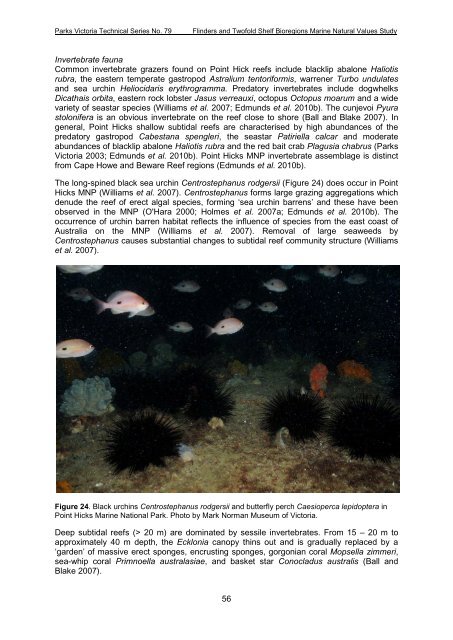parks victoria technical series marine natural values study vol 2 ...
parks victoria technical series marine natural values study vol 2 ...
parks victoria technical series marine natural values study vol 2 ...
Create successful ePaper yourself
Turn your PDF publications into a flip-book with our unique Google optimized e-Paper software.
Parks Victoria Technical Series No. 79<br />
Flinders and Twofold Shelf Bioregions Marine Natural Values Study<br />
Invertebrate fauna<br />
Common invertebrate grazers found on Point Hick reefs include blacklip abalone Haliotis<br />
rubra, the eastern temperate gastropod Astralium tentoriformis, warrener Turbo undulates<br />
and sea urchin Heliocidaris erythrogramma. Predatory invertebrates include dogwhelks<br />
Dicathais orbita, eastern rock lobster Jasus verreauxi, octopus Octopus moarum and a wide<br />
variety of seastar species (Williams et al. 2007; Edmunds et al. 2010b). The cunjevoi Pyura<br />
stolonifera is an obvious invertebrate on the reef close to shore (Ball and Blake 2007). In<br />
general, Point Hicks shallow subtidal reefs are characterised by high abundances of the<br />
predatory gastropod Cabestana spengleri, the seastar Patiriella calcar and moderate<br />
abundances of blacklip abalone Haliotis rubra and the red bait crab Plagusia chabrus (Parks<br />
Victoria 2003; Edmunds et al. 2010b). Point Hicks MNP invertebrate assemblage is distinct<br />
from Cape Howe and Beware Reef regions (Edmunds et al. 2010b).<br />
The long-spined black sea urchin Centrostephanus rodgersii (Figure 24) does occur in Point<br />
Hicks MNP (Williams et al. 2007). Centrostephanus forms large grazing aggregations which<br />
denude the reef of erect algal species, forming ‘sea urchin barrens’ and these have been<br />
observed in the MNP (O'Hara 2000; Holmes et al. 2007a; Edmunds et al. 2010b). The<br />
occurrence of urchin barren habitat reflects the influence of species from the east coast of<br />
Australia on the MNP (Williams et al. 2007). Removal of large seaweeds by<br />
Centrostephanus causes substantial changes to subtidal reef community structure (Williams<br />
et al. 2007).<br />
Figure 24. Black urchins Centrostephanus rodgersii and butterfly perch Caesioperca lepidoptera in<br />
Point Hicks Marine National Park. Photo by Mark Norman Museum of Victoria.<br />
Deep subtidal reefs (> 20 m) are dominated by sessile invertebrates. From 15 – 20 m to<br />
approximately 40 m depth, the Ecklonia canopy thins out and is gradually replaced by a<br />
‘garden’ of massive erect sponges, encrusting sponges, gorgonian coral Mopsella zimmeri,<br />
sea-whip coral Primnoella australasiae, and basket star Conocladus australis (Ball and<br />
Blake 2007).<br />
56

















